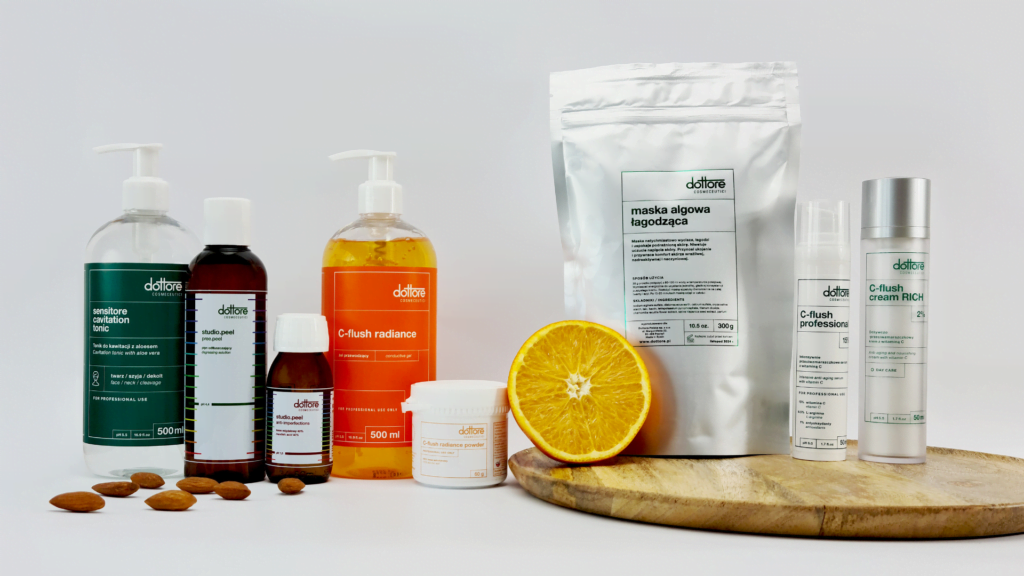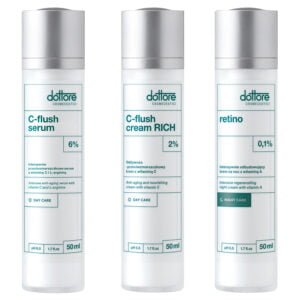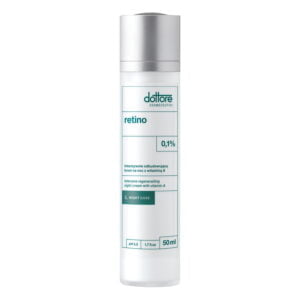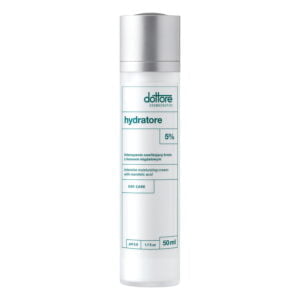Glossary of terms: sebum and seboregulation
Did you know that sebum is essential for proper skin functioning? Unfortunately, both excess and deficiency of this substance is unfavorable. Read the article to learn more about sebum and seboregulation.
Spis treści
Sebum – what is it?
The skin is an organ that requires constant protection. The good condition of this organ depends on the proper course of many natural processes, as well as the additional support of proper care.
Among the skin’s natural protective mechanisms is the production of sebum, or skin tallow. Sebum is a mixture of epithelial lipids. It takes the form of an oily, sticky discharge. Sebaceous glands, located in the dermis almost all over the body, are responsible for its production. The greatest accumulation of sebaceous glands occurs on the face and head. Tallow escapes through the hair follicles to the surface of the skin, where it takes on a slightly acidic pH.
Sebum is part of the hydrolipid barrier. His tasks include:
- protection of the skin from external factors,
- prevention of excessive water loss from the epidermis (TEWL),
- supporting the elasticity of the epidermis,
- maintaining the proper pH of the skin.
Adequate levels of sebum are therefore essential for the health and well-being of the skin. However, there are also a number of skin care challenges associated with sebum.
Sebum and skincare challenges
Sebum accumulates on the surface of the epidermis, where it mixes with dead cells of the stratum corneum, sweat, impurities and makeup residues. All this adds up to an environment conducive to the growth of bacteria, eczema, inflammation and even disease. That’s why regular cleansing and exfoliation of the skin is so important.
Maintaining proper levels of skin sebum production, or seboregulation, is also proving to be a challenge. Both excess sebum and deficiency are unfavorable. Disturbed sebaceous gland activity is a very common problem.
Excessive sebum secretion calledseborrhea makes the skin oily and prone to imperfections. The complexion shines, and the makeup applied on it easily runs off. Pores are dilated, inflammatory lesions, pimples, closed blackheads and open comedones appear. This is especially true for the T-zone on the face, but also for the back, cleavage and other areas on the body. Seborrhea is characteristic of oily skin and of mixed skin. It is one of the causes of acne vulgaris (acne complexion).
In contrast, too little sebum produced by the sebaceous glands is characteristic of dry skin and mature skins. Deficiency of skin sebum causes the skin to dry out, lose elasticity and firmness, become thin and flabby. This makes it susceptible to all kinds of damage and irritation. Low levels of sebum production are often accompanied by feelings of tightness, itching and burning.
Deficiency or excess of sebum – causes
The amount of sebum secretion is partly related to age – the activity of the sebaceous glands gradually decreases. However, this is only one of the factors on which the deficiency or excess of skin sebum depends. The amount of sebum produced is very often related to hormonal balance. Seborrhea usually occurs during puberty, menstruation and peri-menopause.
Factors that determine the amount of sebum also include:
- genetic tendencies,
- improper diet,
- stress,
- impact of UV radiation,
- environmental pollution (e.g. smog),
- digestive disorders,
- changes in temperature and humidity.
Excessive sebum production vs. acne vulgaris
One of the consequences of increased sebum secretion is acne vulgaris. This chronic skin disease does not only affect young people. It can occur at any age, as it is closely related to unregulated sebaceous glands. Symptoms of acne vulgaris are caused by seborrhea, which occurs most often on the face, neck, back, décolleté and shoulders. Overproduction of sebum causespapules, pimples, pustules, nodules, open comedones, closed comedones and purulent cysts. The lesions are often accompanied by inflammation.
Untreated acne and improper acne skin care can lead to post-inflammatory hyperpigmentation, scarring and dangerous complications. In the case of acne vulgaris, seboregulation and deep cleansing of the skin are very important. This applies to both juvenile acne, and adult acne. Some cases of this condition additionally require pharmacotherapy.
Seboregulation
How to regulate the sebaceous glands? Above all, it is important to choose the right home care products. The idea that oily acne-prone skin needs to be dried out is a myth. Any skin, including oily and combination skin or other skin with symptoms of acne vulgaris, requires proper moisturization.
However, before moisturizing oily skin, acne or any other type of skin, it is important to take care of deep cleansing. Another important step in skin care is exfoliation. And where is seboregulation in all this? Well, sebostatic cosmetics can be implemented at almost every stage of skin care. It is important to have a properly arranged skin care plan, that is, one that addresses the specific needs of the skin through precise active ingredients.
A seboregulating cream is an essential part of a beauty plan especially for oily or combination skin. The use of a cosmeceutical with a sebostatic active substance significantly facilitates the reduction of skin problems. Over time, it will also reduce the skin’s susceptibility to acne lesions. All this is possible by acting at the source of the problem – the cream regulates the sebaceous glands. The best seboregulation cream is one that provides the skin not only with normalization of sebum secretion, but also with hydration and nourishment according to the individual needs of the skin.
Seboregulation should be taken care of primarily on a daily basis, at home. Sebostatic substances can be found in the composition of creams and other home care products. It’s also a good idea to visit a cosmetologist or beautician from time to time for a seboregulating (normalizing) cosmetic treatment.
Mandelic acid and other sebostatic active ingredients
There are a number of active ingredients that help control excessive sebum secretion. One of them is mandelic acid. This alpha-hydroxy acid is used in both home care products and professional cosmetic treatments. It is more powerful than, for example, glycolic acid, and thanks to its large molecule, it is devoid of irritant properties. It is an excellent choice for acne vulgaris and oily skin with numerous blackheads.
Mandelic acid can produce spectacular aesthetic results – especially when combined with other ingredients that address the skin’s needs. It happens, for example, that acne-prone skin requires brightening, regeneration, antioxidant protection and reduction of signs of stress and aging, in addition to normalization. In that case, a great idea would beC-flush mandelic – a normalizing and brightening treatment with vitamin C and mandelic acid.

Cosmetics with mandelic acid for the face can be incorporated into year-round home care. Other combinations of active ingredients can also prove valuable, such as retinol and vitamin C as part of a brightening-normalizing treatment. It all depends on the individual needs of the skin. It is worth advising a cosmetologist at a trusted beauty salon on this issue.
The list of effective active ingredients with seboregulatory (sebostatic, normalizing) properties includes:
- mandelic acid
- retinoids
- glycolic acid
- pyruvic acid
- salicylic acid
- shikimic acid
- azelaic acid
- zinc
- witch hazel extract
- jojoba oil
-
 Brightening-normalizing treatment669,00 zł
Brightening-normalizing treatment669,00 zł -
 Retino289,00 zł
Retino289,00 zł -
 Hydratore279,00 zł
Hydratore279,00 zł
Sebum deficiency – what to do?
Much is said about seboregulation for seborrhea (excess sebum), and much less about caring for skin with too little sebum production. Sebum deficiency makes the skin dry, thin, flabby and inflexible. In such a situation, it becomes necessary to rebuild the hydrolipid barrier and stimulate the skin’s natural protective processes. Cosmetics withcomponents of the skin’s natural NMF will be useful. If the decrease in sebaceous gland activity affects mature skin, it is worth getting cosmetics with substances that increase skin firmness and elasticity, such as peptides.
Oily skin, acne-prone skin. How else to regulate sebum?
Proper care for acne-prone skin, oily skin or combination skin is essential, but it can be supported by additional actions. These include:
- a diet rich in EFAs – be sure to include omega acids, which dilute sebum and make the skin less prone to imperfections;
- providing vitamin A, C, E, B vitamins, zinc, selenium and silicon;
- limiting sweets, highly processed foods, alcohol, sugar, fast food, dairy products;
- hydration of the body;
- hygiene – washing the skin with lukewarm water;
- fighting the habit of touching the face and hair (this causes faster greasiness).




No Comments